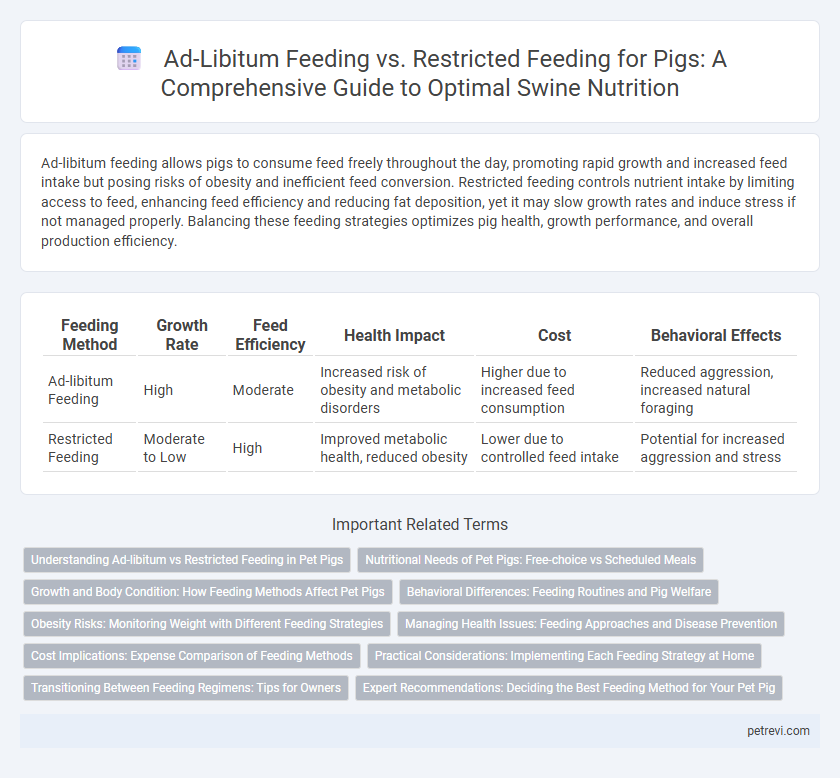Ad-libitum feeding allows pigs to consume feed freely throughout the day, promoting rapid growth and increased feed intake but posing risks of obesity and inefficient feed conversion. Restricted feeding controls nutrient intake by limiting access to feed, enhancing feed efficiency and reducing fat deposition, yet it may slow growth rates and induce stress if not managed properly. Balancing these feeding strategies optimizes pig health, growth performance, and overall production efficiency.
Table of Comparison
| Feeding Method | Growth Rate | Feed Efficiency | Health Impact | Cost | Behavioral Effects |
|---|---|---|---|---|---|
| Ad-libitum Feeding | High | Moderate | Increased risk of obesity and metabolic disorders | Higher due to increased feed consumption | Reduced aggression, increased natural foraging |
| Restricted Feeding | Moderate to Low | High | Improved metabolic health, reduced obesity | Lower due to controlled feed intake | Potential for increased aggression and stress |
Understanding Ad-libitum vs Restricted Feeding in Pet Pigs
Ad-libitum feeding allows pet pigs continuous access to food, promoting natural eating behaviors and supporting steady weight gain, but it may increase the risk of obesity and related health issues. Restricted feeding involves controlled meal portions and timing, helping regulate growth and prevent overfeeding, which is crucial for maintaining optimal body condition in pet pigs. Understanding the balance between these feeding methods is essential to ensure proper nutrition, prevent metabolic disorders, and enhance the overall welfare of pet pigs.
Nutritional Needs of Pet Pigs: Free-choice vs Scheduled Meals
Ad-libitum feeding allows pet pigs to consume food at will, promoting natural eating behaviors and potentially improving growth rates by meeting their nutritional needs continuously. Restricted feeding, involving scheduled meals, helps control calorie intake and prevents obesity, ensuring balanced nutrition tailored to the pig's specific age, weight, and health status. Optimizing feeding strategies for pet pigs requires balancing free-choice access and portion control to support healthy metabolism and overall well-being.
Growth and Body Condition: How Feeding Methods Affect Pet Pigs
Ad-libitum feeding in pet pigs promotes rapid growth and increased body fat due to unrestricted access to food, often leading to obesity and related health issues. Restricted feeding controls calorie intake, supporting leaner body composition and minimizing excessive weight gain while maintaining steady growth rates. Balancing nutrient needs with feeding strategies is crucial to optimize pet pigs' health, growth, and body condition.
Behavioral Differences: Feeding Routines and Pig Welfare
Ad-libitum feeding allows pigs to eat freely throughout the day, promoting natural foraging behavior and reducing aggressive competition, which enhances overall welfare. Restricted feeding schedules can induce stress-related behaviors such as increased vocalizations and stereotypies, negatively impacting mental health. Implementing feeding routines that balance nutrient intake and behavioral needs is essential to improving pig welfare and reducing welfare-related issues.
Obesity Risks: Monitoring Weight with Different Feeding Strategies
Ad-libitum feeding in pigs often leads to excessive calorie intake, increasing the risk of obesity and associated metabolic disorders. Restricted feeding schedules help control energy consumption, promoting healthier weight maintenance and reducing fat deposition. Regular weight monitoring is essential for adjusting feeding protocols to prevent obesity-related complications in pigs.
Managing Health Issues: Feeding Approaches and Disease Prevention
Ad-libitum feeding in pigs allows continuous access to feed, supporting natural eating behaviors but may increase the risk of obesity and metabolic disorders, complicating health management. Restricted feeding controls nutrient intake and helps prevent digestive issues, such as gastric ulcers and obesity-related problems, by limiting overeating and promoting balanced growth. Careful implementation of feeding regimens tailored to the pig's age and health status is essential for optimizing disease prevention and overall herd health.
Cost Implications: Expense Comparison of Feeding Methods
Ad-libitum feeding for pigs incurs higher feed costs due to unrestricted consumption, often leading to increased waste and inefficient feed conversion ratios. Restricted feeding reduces overall feed expenses by controlling intake, optimizing growth rates, and minimizing feed wastage. Cost-benefit analysis reveals that while ad-libitum feeding promotes faster growth, restricted feeding yields better economic efficiency by lowering feed costs per kilogram of weight gain.
Practical Considerations: Implementing Each Feeding Strategy at Home
Ad-libitum feeding allows pigs constant access to feed, promoting rapid growth but increasing feed costs and risk of obesity, requiring careful monitoring of pig health and pen hygiene. Restricted feeding controls intake to optimize growth efficiency and reduce waste, necessitating precise ration formulation and consistent feeding schedules to prevent aggression and stress among pigs. Implementing either strategy at home demands suitable feeders, regular observation of eating behavior, and adjustments according to pig age, breed, and production goals.
Transitioning Between Feeding Regimens: Tips for Owners
When transitioning pigs from ad-libitum feeding to restricted feeding, gradual adjustment is crucial to prevent stress and digestive issues. Owners should decrease feed amounts incrementally over 7 to 10 days while monitoring pig behavior and body condition closely. Providing consistent feeding times and ensuring access to fresh water supports a smooth transition and promotes optimal health.
Expert Recommendations: Deciding the Best Feeding Method for Your Pet Pig
Expert recommendations for feeding pet pigs emphasize the importance of balancing nutritional needs with health management when choosing between ad-libitum and restricted feeding. Ad-libitum feeding allows pigs to eat freely, promoting natural behavior but risks overconsumption and obesity, while restricted feeding controls portion sizes to prevent obesity and metabolic disorders, requiring careful monitoring. Veterinary nutritionists often advise tailored feeding plans based on the pig's age, weight, activity level, and health status to optimize growth and longevity.
Ad-libitum feeding vs Restricted feeding for Pigs Infographic

 petrevi.com
petrevi.com